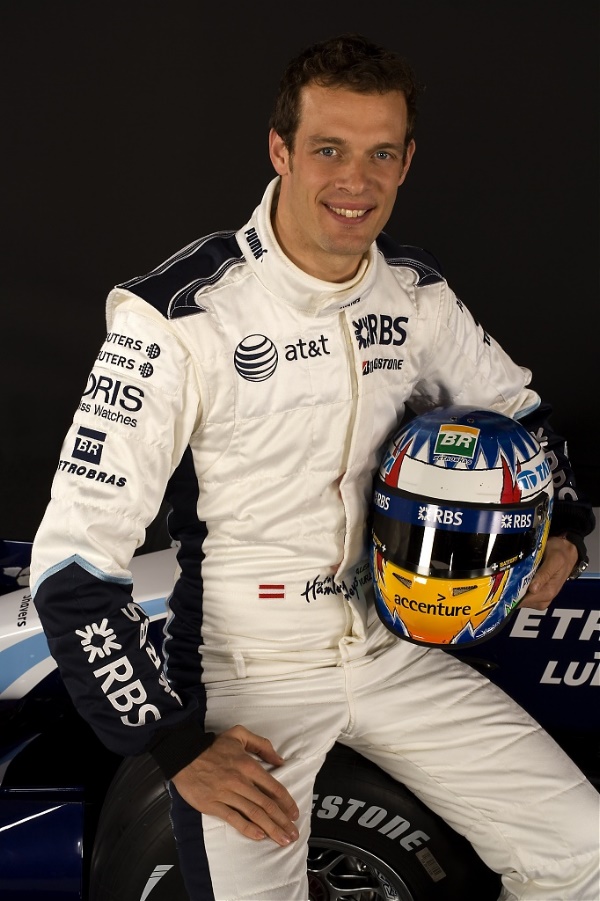Lap of Hockenheim with Alex Wurz
 |
| Honda's Alex Wurz |
Round ten of the 2008 FIA Formula One World Championship takes the F1 teams to Hockenheim for the German Grand Prix. The 4.574km (2.842-mile) circuit is situated on the banks of the River Rhine, between the cities of Frankfurt and Stuttgart, and is making a return to the F1 calendar after sitting out 2007.
The track was built in 1939, but racing only took off at the venue in 1964 when Dutch circuit designer John Hugenholz, who also penned the Honda-owned Suzuka Circuit, created the 6.8km (4.2-mile) layout that was to remain largely unchanged until 2001. It was on this track, which had an average speed in excess of 242kph (150mph), that the Honda Racing F1 Team's driver Rubens Barrichello scored his maiden F1 victory in 2000.
Hockenheim was re-designed by Hermann Tilke in 2002 when the circuit was shortened and safety improvements were made. The mix of long straights and a twisty infield provides the teams and drivers with an interesting technical challenge and the 67-lap race is sometimes incident-packed.
Technical Challenge
The new Hockenheim is a very different challenge to the old layout. What was once a flat-out blast through the forest is now a modern stadium circuit, but the old Motodrom section, with its testing mix of elevation changes and double-apex corners, has been retained in the new layout.
Car set-up is a compromise between this very twisty infield section and the straights at the back of the circuit. The teams spent last week's three-day test session at the track trying to establish good levels of mechanical grip with their cars, while minimizing the amount of aerodynamic downforce in order to be fast in a straight line.
Stability under braking is also important because there are a number of heavy braking areas on the lap, particularly at the Spitzkehre hairpin (Turn 6) where the cars slow from 310kph (193mph) to 60kph (37mph). It's one of the slowest corners on the Formula One calendar and the best overtaking point at Hockenheim.
With only two high-speed corners on the lap, into and out of the Motodrom, tire wear is not such a factor at this race, but the high track temperatures sometimes witnessed in late July can create large fluctuations in grip.
Full throttle: 65% Brake wear: Medium
Downforce level: Medium – 7/10
Tire compounds: Hard / Medium Tire usage: Medium Average
Speed: 215kph (134mph)
A lap of Hockenheim with Honda’s Alex Wurz
 |
| Hockenheim |
"The most memorable thing about Hockenheim is the stadium section because the huge grandstands create an amazing atmosphere. There are thousands of people, all making a lot of noise and that sounds pretty cool when you're on the drivers' parade. As for the circuit, in my view it has become just another racetrack since it was re-designed in 2002, but it's still quite challenging.
"You arrive at Turn 1 in sixth gear, at just over 270kph (168mph). You brake only for a very short period, downshift one gear and flick the car towards the apex. You need to have very good turn-in here, otherwise you'll understeer wide at the exit and lose time down the following straight.
"Turn 2 is a strange corner because it's slippery and bumpy under braking. You have to force yourself to brake early so that you can get on the power early at the exit, which is important because the longest straight on the lap comes next. As you're getting on the power, the car is loaded up with lateral Gs and you have to feed in the power progressively to avoid too much wheelspin.
"We reach a top speed of 310kph (193mph) on the next straight, before braking for the hairpin. It's a very slow corner, first gear at 60kph (37mph), and is the best overtaking spot on the lap. There's lots of run-off so you can try some really creative moves if you need to. It's important to get good traction at the exit because you accelerate up to sixth gear before to Turn 7, which is easy flat, and you arrive at the next left-hander at 280kph (174mph). "The car slides through these two lefts and it's easy to miss your apex. You accelerate all the way through the next corner, a right-hander, although you might lift a tiny bit at the entry to get the front end turned in. By the exit you're in fifth gear and heading back towards the stadium.
"Turn 12 is the most challenging corner on the lap. It's fast, 270kph (168mph) at the entry, and bumpy, and the track narrows at the exit, so you have to be very precise with your line. You need to use the exit curb to be fast, but you mustn't go wider than that because the Astroturf on the outside is slippery and you can lose a lot of time.
"A banked second gear left-hander comes next and the gradient helps you to carry a lot of speed at the apex. However, the gradient flattens out while the car is still loaded up at the exit, so you have to be prepared for some oversteer. A left-right flick follows, after which there's a compression that helps you get the car turned into the last couple of right-handers. You have to open up the steering slightly between these corners, but they are more like one double-apex corner than two separate ones. Then it's important to get a good exit in order to carry as much speed over the start-finish line."
